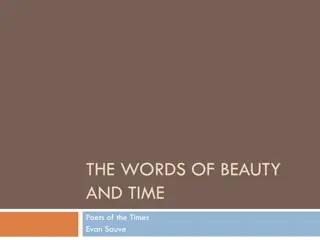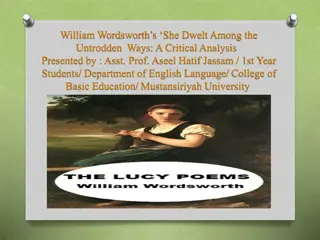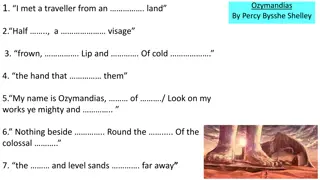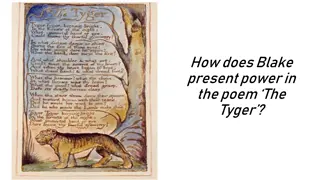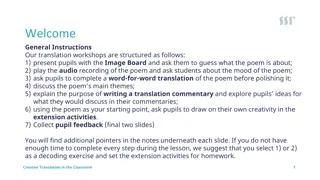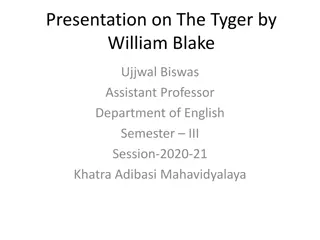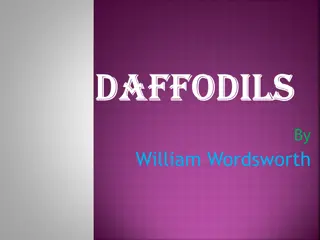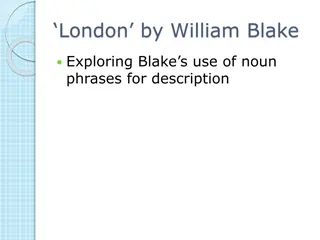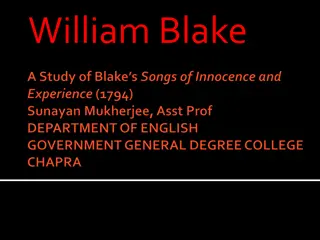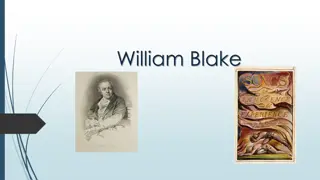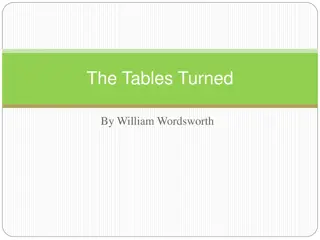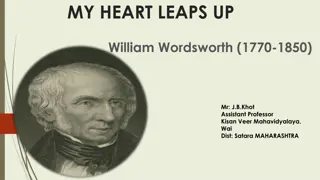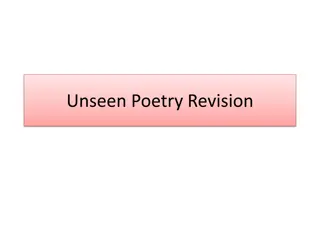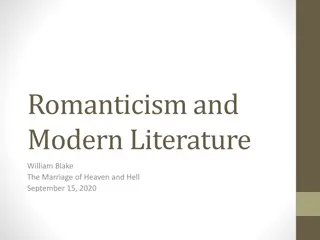Analysis of William Blake's Poem "The Tyger
The poem "The Tyger" by William Blake, published in his 1794 volume, Songs of Experience, contrasts with his earlier work, "The Lamb." It delves into the creation of the fearsome tiger, questioning the divine creator and the symbol of fire, strength, and danger conveyed by the tiger. The speaker wonders about God's intention in creating such a powerful and ferocious creature, challenging traditional ideas of God's benevolence. Blake uses vivid imagery and metaphorical comparisons to explore the complexities of creation and the darker aspects of existence.
Download Presentation

Please find below an Image/Link to download the presentation.
The content on the website is provided AS IS for your information and personal use only. It may not be sold, licensed, or shared on other websites without obtaining consent from the author.If you encounter any issues during the download, it is possible that the publisher has removed the file from their server.
You are allowed to download the files provided on this website for personal or commercial use, subject to the condition that they are used lawfully. All files are the property of their respective owners.
The content on the website is provided AS IS for your information and personal use only. It may not be sold, licensed, or shared on other websites without obtaining consent from the author.
E N D
Presentation Transcript
William Blakes The Tyger The Tyger was first published in William Blake s 1794 volume Songs of Experience, which contains many of his most celebrated poems. The Songs of Experience was designed to complement Blake s earlier collection, Songs of Innocence (1789), and The Tyger should be seen as the later volume s answer to The Lamb , the innocent poem that had appeared in the earlier volume.
Framed as a series of questions, Tyger Tyger, burning bright (as the poem is also often known), in summary, sees Blake s speaker wondering about the creator responsible for such a fearsome creature as the tiger. The fiery imagery used throughout the poem conjures the tiger s aura of danger: fire equates fear. Don t get too close to the tiger, Blake s poem seems to say, otherwise you ll get burnt.
The first stanza and sixth stanza, alike in every respect except for the shift from Could frame to Dare frame , frame the poem, asking about the immortal creator responsible for the beast. The second stanza continues the fire imagery established by the image of the tiger burning bright , with talk of the fire of the creature s eyes, and the notion of the creator fashioning the tiger out of pure fire, as if he (or He) had reached his hand into the fire and molded the creature from it. (The image succeeds, of course, because of the flame-like appearance of a tiger s stripes.) It must have been a god who played with fire who made the tiger.
In the third and fourth stanzas, Blake introduces another central metaphor, explicitly drawing a comparison between God and a blacksmith. It is as if the Creator made the blacksmith in his forge, hammering the base materials into the living and breathing ferocious creature which now walks the earth. The fifth stanza is more puzzling. When the Creator fashioned the Tyger, Blake asks, did he look with pride upon the animal he had created? if God is all-loving, why did he make such a fearsome and dangerous animal? We can t easily fit the tiger into the All Things Bright and Beautiful view of Christian creation. As Blake himself asks, Did he who made the Lamb make thee? In other words, did God make the gentle and meek animals, but also the destructive and ferocious ones? Presumably the question is rhetorical; the real question-behind-the-question is why. (This might help to explain Blake s reference to fearful symmetry )
The Symbolism of the Poem The Tyger by William Blake is taken from The Songs of Experience. The tiger itself is a symbol for the fierce forces in the soul that are necessary to experience. The tiger also stands for a divine spirit that will not be subdued by restrictions, but will arise against established rules and conventions. break the bonds of
The Tyger is a highly symbolic poem based on Blake s personal philosophy of spiritual and intellectual revolution by individuals. The speaker in the poem is puzzled at the sight of a tiger in the night, and he asks it a series of questions about its fierce appearance and about the creator who made it.
The Tyger is a symbolic tiger which represents the fierce force in the human soul. It is created in the fire of imagination by the god who has a supreme imagination, spirituality and ideals. The anvil, chain, hammer, furnace and fire are parts of the imaginative artist s powerful means of creation. The imaginative artist is synonymous with the creator. The man with a revolutionary spirit can use such powers to fight against the evils of experience.
So, the god creating the tiger can be interpreted as any of these creative agents which inspire common men to free their minds, hearts and souls from the chains of social falsities- the king, the priest, the landlord and their systems that eat up the individual s potentials. The creator has strong shoulders (energy) as well as art (skills) and dread feet and hand. His courage is supreme, too. His creation is fierce, almost daunting himself. The forest is the symbol of corrupted social conventions and that tries to suppress the good human potentials. In the poem night stands for ignorance, out of which the forest of false social institutions is made.
The poem is taken from the Songs of Experience which means the adult world of corruption, immorality and suffering. Passing through the first phase of Innocence or the pure child s-like world or mentality in Songs of Innocence , and then having experienced the opposite world of experience, the speaker in this poem has begun to recognize the suppressed power of his soul and realize its necessity. He is himself puzzled at its fearful faces, and begins to realize that he had gotten, not only the lamb-like humility, but also the tiger-like energy for fighting back against the domination of the evil society. The qualities of the original and pure man must be freed by using this tiger- like force of the soul. Blake s imaginative man or creative artist is a rebellious being. It also represents the double potentials in any human being. Thematically, the poem is intended to make us to witness the persona realizing the potentials of his soul and to realize it ourselves. We have not only the lamb (Christ) like humility but also the tiger like quality for spiritual revolution and freedom from falsities. The unusual spelling in Tyger is also a hint of the special meaning and emphasis as the unusual stresses. The use of the first stanza as a refrain repeating it with the difference of one word (dare) at the end is also for special emphasis on its symbolism.


